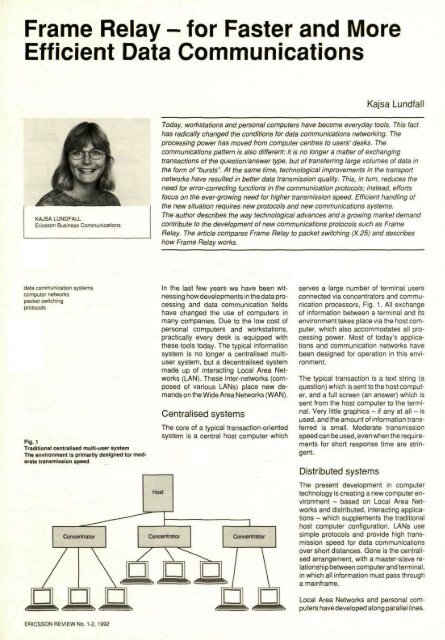Frame Relay - for Faster and More Efficient Data Communications ...
Frame Relay - for Faster and More Efficient Data Communications ...
Frame Relay - for Faster and More Efficient Data Communications ...
- No tags were found...
You also want an ePaper? Increase the reach of your titles
YUMPU automatically turns print PDFs into web optimized ePapers that Google loves.
<strong>Frame</strong> <strong>Relay</strong> - <strong>for</strong> <strong>Faster</strong> <strong>and</strong> <strong>More</strong><strong>Efficient</strong> <strong>Data</strong> <strong>Communications</strong>Kajsa LundfallKAJSA LUNDFALLEricsson Business <strong>Communications</strong>Today, workstations <strong>and</strong> personal computers have become everyday tools. This fachas radically changed the conditions <strong>for</strong> data communications networking. Theprocessing power has moved from computer centres to users' desks. Thecommunications pattern is also different: it is no longer a matter of exchangingtransactions of the question/answer type, but of transferring large volumes of data inthe <strong>for</strong>m of "bursts". At the same time, technological improvements in the transportnetworks have resulted in better data transmission quality. This, in turn, reduces theneed <strong>for</strong> error-correcting functions in the communication protocols; instead, ef<strong>for</strong>tsfocus on the ever-growing need <strong>for</strong> higher transmission speed. <strong>Efficient</strong> h<strong>and</strong>ling ofthe new situation requires new protocols <strong>and</strong> new communications systems.The author describes the way technological advances <strong>and</strong> a growing market dem<strong>and</strong>contribute to the development of new communications protocols such as <strong>Frame</strong><strong>Relay</strong>. The article compares <strong>Frame</strong> <strong>Relay</strong> to packet switching (X.25) <strong>and</strong> describeshow <strong>Frame</strong> <strong>Relay</strong> works.data communication systemscomputer networkspacket switchingprotocolsFig. 1Traditional centralised multi-user systemThe environment is primarily designed <strong>for</strong> moderatetransmission speedIn the last few years we have been witnessinghow developments in the data processing<strong>and</strong> data communication fieldshave changed the use of computers inmany companies. Due to the low cost ofpersonal computers <strong>and</strong> workstations,practically every desk is equipped withthese tools today. The typical in<strong>for</strong>mationsystem is no longer a centralised multiusersystem, but a decentralised systemmade up of interacting Local Area Networks(LAN). These inter-networks (composedof various LANs) place new dem<strong>and</strong>son the Wide Area Networks (WAN).Centralised systemsThe core of a typical transaction-orientedsystem is a central host computer whichserves a large number of terminal usersconnected via concentrators <strong>and</strong> communicationprocessors, Fig. 1. All exchangeof in<strong>for</strong>mation between a terminal <strong>and</strong> itsenvironment takes place via the host computer,which also accommodates all processingpower. Most of today's applications<strong>and</strong> communication networks havebeen designed <strong>for</strong> operation in this environment.The typical transaction is a text string (aquestion) which is sent to the host computer,<strong>and</strong> a full screen (an answer) which issent from the host computer to the terminal.Very little graphics - if any at all - isused, <strong>and</strong> the amount of in<strong>for</strong>mation transferredis small. Moderate transmissionspeed can be used, even when the requirements<strong>for</strong> short response time are stringent.Distributed systemsThe present development in computertechnology is creating a new computer environment- based on Local Area Networks<strong>and</strong> distributed, interacting applications- which supplements the traditionalhost computer configuration. LANs usesimple protocols <strong>and</strong> provide high transmissionspeed <strong>for</strong> data communicationsover short distances. Gone is the centralisedarrangement, with a master-slave relationshipbetween computer <strong>and</strong> terminal,in which all in<strong>for</strong>mation must pass througha mainframe.Local Area Networks <strong>and</strong> personal computershave developed along parallel lines.ERICSSON REVIEW No. 1-2, 1992















